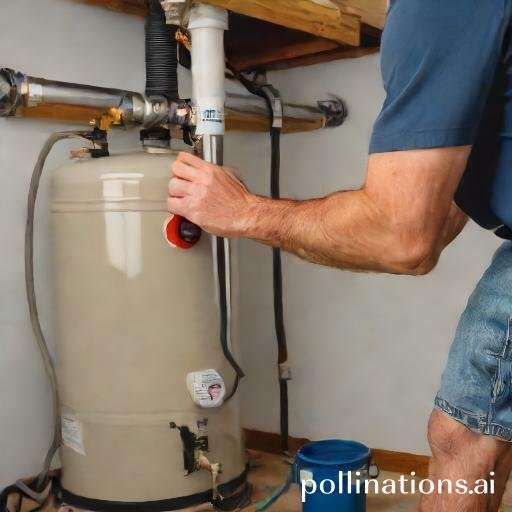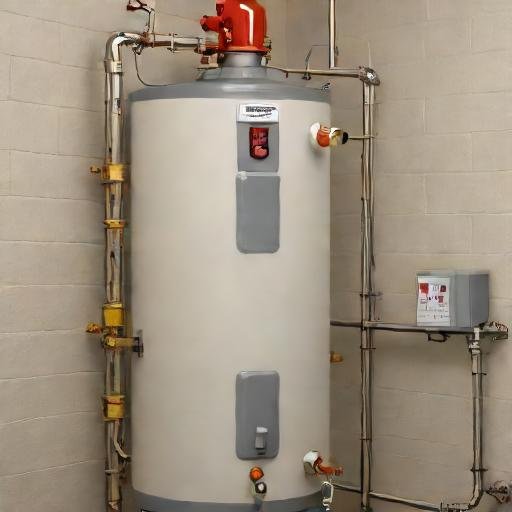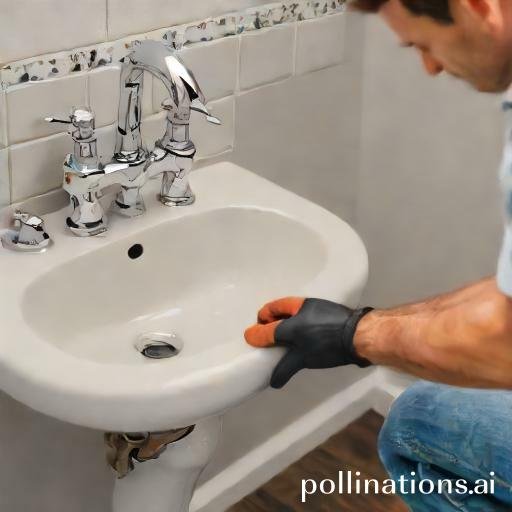
II. Professional water heater service ensures thorough cleaning and inspection of the unit, preventing future breakdowns and extending its lifespan.
III. Choosing between DIY flushing and professional service depends on the user’s budget, schedule, and level of expertise, as well as the age and condition of the water heater.
In the realm of maintaining your water heater, you have two options: DIY flushing or hiring a professional service. DIY flushing involves draining and cleaning the water heater yourself, at the same time professional service involves hiring a trained technician to handle the task.
Both options have their pros and cons, and it’s important to weigh them carefully before making a decision. In this article, we will discuss the benefits and drawbacks of each approach, helping you make an informed choice for your water heater maintenance needs.
What is water heater flushing?
Water heater flushing is the process of removing sediment and mineral buildup from the tank of a water heater. Over time, minerals and debris can accumulate at the bottom of the tank, which can reduce the efficiency and lifespan of the water heater.
1. Definition of water heater flushing
Water heater flushing involves draining the tank and flushing it with clean water to remove any sediment or debris that has settled at the bottom. This process helps to maintain the performance and efficiency of the water heater.
2. Importance of flushing in maintaining water heater efficiency and lifespan
Flushing your water heater regularly is important to ensure its efficiency and prolong its lifespan. The buildup of sediment and minerals can insulate the heating element, making it less efficient and increasing energy consumption. Flushing removes this buildup and allows the water heater to operate more effectively, reducing energy costs in the long run. Additionally, flushing helps prevent corrosion and extends the lifespan of the water heater, saving you money on expensive repairs or replacements.
3. Signs that indicate the need for water heater flushing
There are several signs that indicate the need for water heater flushing:
- Reduced hot water supply: If you notice a decrease in the amount of hot water available or the water takes longer to heat up, it may be a sign that there is sediment buildup in the tank.
- Strange noises: If you hear popping or rumbling noises coming from your water heater, it could be a result of sediment buildup, causing the heating element to work harder.
- Foul odor or discolored water: Sediment can cause the water to have a strange smell or appear discolored. Flushing the water heater can help eliminate these issues.
Regular water heater flushing is essential to maintain its efficiency, extend its lifespan, and ensure a reliable supply of hot water. By abiding by the proper flushing procedures and scheduling regular maintenance, you can keep your water heater performing optimally for years to come.
| Benefits of Water Heater Flushing | Importance of Regular Maintenance |
|---|---|
| 1. Improved Efficiency: Flushing removes sediment that can insulate the heating element, allowing the water heater to operate more efficiently. | 1. Energy Savings: Regular maintenance, including flushing, can reduce energy consumption and lower utility bills. |
| 2. Extended Lifespan: Flushing helps prevent corrosion and extends the lifespan of the water heater, saving you money on repairs or replacements. | 2. Cost Savings: By maintaining your water heater through regular flushing, you can avoid costly repairs or premature replacements. |
| 3. Reliable Hot Water Supply: Flushing removes sediment that can clog pipes and reduce the availability of hot water. | 3. Avoiding Water Damage: Regular maintenance, including flushing, helps prevent leaks and potential water damage. |
DIY Flushing: Pros and Cons
Flushing your system is an essential maintenance task that helps keep it running smoothly and efficiently. During hiring a professional service is always an option, many homeowners prefer the cost-effective and hands-on approach of DIY flushing. In this section, we will ponder the pros and cons of taking on this task yourself.
1. Steps for DIY Flushing
In the realm of DIY flushing, following the correct steps is crucial for a successful outcome. Begin by gathering all the necessary tools and materials, which may include a flush kit, a bucket, a wrench, and a hose. Next, shut off the water supply to your system and drain any water from the pipes. Connect the flush kit to the system and follow the manufacturer’s instructions to flush out any sediment or debris. Finally, reconnect everything and turn on the water supply to complete the process.
2. Tools and Materials Required for DIY Flushing
To ensure a smooth DIY flushing experience, it is essential to have the right tools and materials at hand. A flush kit, which typically includes a hose and a nozzle, is a must-have. Additionally, a bucket will come in handy for collecting any water or sediment that is flushed out. A wrench may be needed to disconnect and reconnect pipes, depending on your system. Having these tools readily available will make the process much more efficient.
3. Risks and Challenges of DIY Flushing
Meanwhile DIY flushing offers many benefits, it is essential to be aware of the potential risks and challenges involved. One of the main risks is causing damage to your system if the flushing process is not done correctly. It is crucial to follow the instructions carefully and ensure proper water pressure is maintained throughout. Additionally, DIY flushing may not be suitable for complex or older systems, as they may require professional expertise.
4. Cost Comparison of DIY Flushing vs. Professional Service
Cost is often a significant consideration when deciding between DIY flushing and hiring a professional service. DIY flushing is generally more cost-effective, as it eliminates the need for labor costs. Notwithstanding, fundamental to note that if any damage occurs during the process, repairs may end up being more costly than hiring a professional in the first place. Assessing your skills, the complexity of your system, and the potential risks will help you make an informed decision.
Professional Water Heater Service: Ensuring Efficiency and Longevity
In the realm of maintaining a properly functioning water heater, seeking professional assistance can make all the difference. In this section, we will ponder the various aspects of professional water heater service, including its types, benefits, risks, drawbacks, and cost comparison with DIY flushing.
Types of Professional Water Heater Services Available
Professional water heater service encompasses a range of options to cater to different needs. These services include routine maintenance, inspection, repair, and installation. By opting for professional assistance, you can ensure that your water heater is in expert hands.
Benefits of Professional Service
One of the key advantages of professional water heater service is the expertise and experience that professionals bring to the table. They possess in-depth knowledge of various water heater models and can identify and resolve issues efficiently. Additionally, professional service providers use advanced tools and techniques to enrich the performance and efficiency of your water heater.
Risks and Drawbacks of Professional Service
At the same time professional water heater service offers numerous benefits, it is essential to consider potential risks and drawbacks. One potential drawback is the cost associated with professional service, as it may be higher compared to DIY options. Additionally, scheduling appointments and waiting for service providers can sometimes be inconvenient. Conversely, the expertise and quality assurance provided by professionals often outweigh these minor inconveniences.
Cost Comparison of Professional Service vs. DIY Flushing
When contemplating water heater maintenance, cost comparison between professional service and DIY flushing is crucial. During DIY flushing may seem cost-effective, it is essential to assess the level of skill and knowledge required. Improper flushing techniques can lead to damage and void warranties. In contradistinction, professional service ensures proper flushing, preventing sediment buildup and prolonging the lifespan of your water heater.

When to Choose DIY Flushing and When to Hire a Professional
Flushing your system is an important maintenance task that helps ensure the longevity and efficiency of your equipment. Whether you should opt for a DIY approach or hire a professional depends on several factors that warrant careful consideration.
Factors to Consider when Deciding Between DIY Flushing and Professional Service
- Experience and Expertise: Assess your own knowledge and skills in flushing systems. If you have prior experience and feel confident in your abilities, DIY flushing may be a viable option. Albeit, if you lack the necessary expertise, it’s best to leave the task to a professional.
- Complexity of the System: Consider the complexity of your system. Some systems require specialized tools and technical expertise to flush properly. If your system falls into this category, it’s advisable to hire a professional who has the necessary equipment and know-how.
- Time and Effort: DIY flushing can be time-consuming and labor-intensive. If you have limited time or prefer to avoid the physical exertion, hiring a professional can save you valuable time and effort.
- Cost Considerations: Evaluate your budget and compare the costs involved in DIY flushing versus hiring a professional service. Whilst DIY may seem cost-effective initially, it’s essential to weigh potential risks and expenses that could arise from improper flushing.
Guidelines for Making the Decision
Here are some guidelines to help you make an informed decision:
- Evaluate your own skills and experience.
- Assess the complexity of your system.
- Weigh the time and effort required.
- Consider the potential costs and risks.
- Research reputable professional service providers.
Tips for Choosing a Reliable Professional Service Provider
When hiring a professional service provider for system flushing, it’s crucial to select a reliable and experienced team. Consider the following tips:
- Check for certifications and licenses to ensure the provider meets industry standards.
- Read reviews and testimonials from previous customers to gauge the quality of their work.
- Inquire about their experience and expertise in flushing systems similar to yours.
- Request a detailed cost estimate and compare it with other service providers.
- Ask for references and contact them to assess customer satisfaction.

How to Maintain Your Water Heater After Flushing
Regular maintenance is crucial for ensuring the longevity and efficiency of your water heater. After flushing your water heater, pivotal to follow a few best practices to keep it in optimal condition. Here are some tips to help you maintain your water heater:
1. Inspect for Leaks
After flushing your water heater, carefully inspect all the connections and valves for any signs of leaks. Even a small leak can lead to significant water damage if left unattended. If you notice any leaks, promptly repair or replace the affected parts to prevent further issues.
2. Check the Temperature and Pressure Relief Valve
The temperature and pressure relief valve is a vital safety component of your water heater. Make sure it is working correctly by testing it after flushing. Lift the lever on the valve to release some water and ensure that it stops flowing when you release the lever. If the valve is faulty, it should be replaced immediately.
3. Insulate the Pipes
To improve energy efficiency and reduce heat loss, consider insulating the hot water pipes connected to your water heater. This can help maintain the temperature of the water as it travels to your faucets, reducing the workload on your water heater and saving energy.
4. Set the Temperature
Adjusting the temperature settings on your water heater can also contribute to its overall maintenance. Set the temperature to a safe and comfortable level, usually between 120-140 degrees Fahrenheit. This will help prevent scalding and minimize the risk of bacterial growth.
5. Regularly Drain Sediment
Flushing your water heater helps remove sediment buildup, but it’s important to continue this maintenance practice regularly. Draining a few gallons of water from the heater every few months can prevent sediment from settling at the bottom, ensuring optimal performance and efficiency.
Common Mistakes to Avoid After Flushing
- Turning the Heater On Immediately: Allow the water heater to fill up completely before turning it back on to avoid damage to the heating elements.
- Skipping Regular Maintenance: Flushing your water heater is just one part of maintenance. Be sure to follow a regular maintenance schedule to keep it in excellent condition.
- Ignoring Unusual Noises or Odors: If you notice any strange noises or foul odors after flushing, it could indicate a problem. Contact a professional plumber to inspect and address the issue.
Bottom Line
Pertaining to maintaining your water heater, you have two options: DIY flushing or professional service. Meanwhile DIY flushing can save you money, it requires time, effort, and knowledge. Nevertheless, professional service may cost more, but it ensures that your water heater is properly maintained and can prevent costly repairs in the future.
Ultimately, the decision between DIY flushing and professional service depends on your budget, schedule, and comfort level with DIY projects. If you have the time and skills, DIY flushing can be a viable option. Nonetheless, if you want peace of mind and a guarantee of quality service, professional water heater service is the way to go.
Read More:
1. Flushing As A Preventive Water Heater Maintenance
2. Can I Use A Descaler For Water Heater Flushing?











